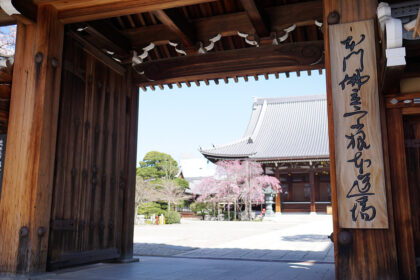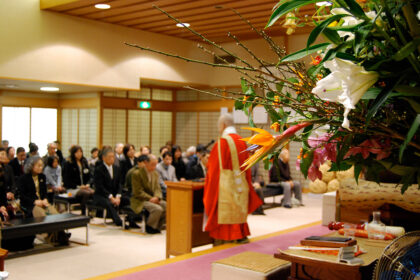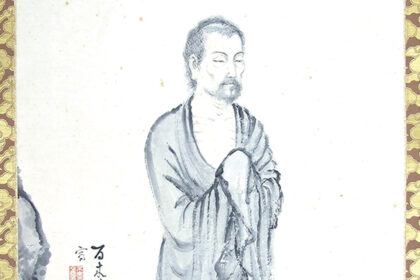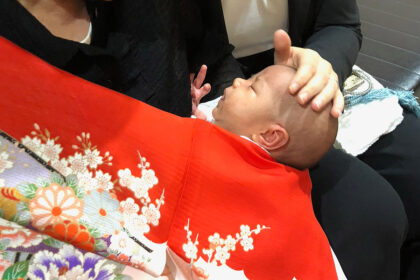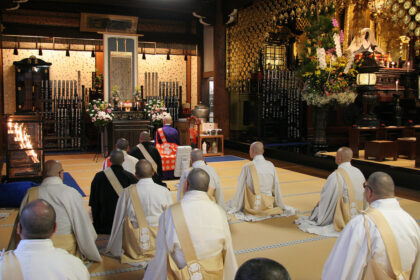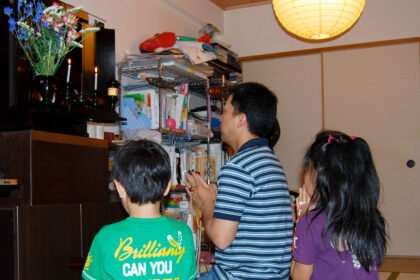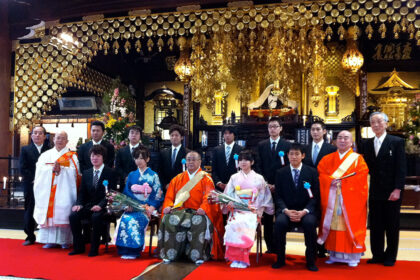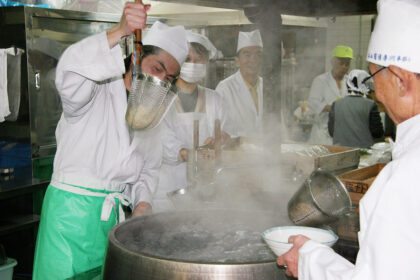Honmon Butsuryū Shū 本門佛立宗 follower’s morning starts with two practices: Okyūji お給仕 (meaning serving or taking care of) of Gokaidan 御戒壇 (HBS family Buddhist altar) and Okankin 御看経 (chanting Odaimoku 御題目). Okyūji consists of the following:
1. Cleaning the Gokaidan which is the dwelling of Gohonzon and the three great masters (Nichiren 日蓮, Nichiryū 日隆 and Nissen Shōnin 日扇聖人).
2. Offering flowers, water, and some food on the altar.
Okankin means “chanting Odaimoku” in Japanese. It is the main practice of HBS followers, but it is also included in Okyūji because it is done to please Gohonzon.
First: Ohatsu-mizu お初水 (first-drawn water of the day)
To start our day we draw fresh water out of a faucet first thing in the morning. We offer water, which is essential to the life of not only human beings, but also plants and animals, to Gohonzon every morning. After turning on the faucet, we leave the water flowing for a few seconds in order to draw clean, freshwater coming from the pipe outside the house. This first-drawn water is offered to Gohonzon after we clean Gokaidan.
Second: Obuppan お佛飯 (offering a bowl of rice)
Next, we prepare another offering called Obuppan. We offer the day’s first bowl of rice to Gohonzon because rice is our staple food and has been the most important source of nourishment for centuries. We boil rice for Obuppan first thing in the morning and offer it together with water. If bread is your usual breakfast, you can offer some bread instead.
Third: Cleaning Gokaidan (the dwelling of Gohonzon)
After preparing Ohatsu-mizu and Obuppan, we clean Gokaidan with a duster and a polishing cloth. Both of them are used only to clean the altar. We take a bath and clean our house every day, so we should also clean Gokaidan in which Gohonzon is enshrined.
Finally: Okankin—the most important thing
After cleaning Gokaidan, we offer Ohatsu-mizu and Obuppan to Gohonzon and chant Odaimoku. Actually, when we say Okankin, it means a small Buddhist service focused on chanting Odaimoku, but also including prayers to Gohonzon for further propagation of HBS, our health, the safety of our family, peace of our ancestors’ souls, and other things. Okankin is also called Gohōmi 御法味. Go 御 is an honorific prefix, Hō 法 literally means Buddhism, and Mi 味 means taste. Gohōmi is the word that compares the profound meanings of Buddhism to the rich flavor of food. Therefore, Gohōmi means that our voice chanting Odaimoku is in itself an offering. It is the best offering we can give Gohonzon.
Every member of our family can live a peaceful life everyday under the protection of Gohonzon if the head of the family dutifully performs the morning Okyūji, despite being busy or sleepy. Honmon Butsuryū Shū places great importance on the tradition of Ohatsuho お初穂. Hatsuho 初穂 originally meant ripe rice ears presented to gods (Shinto 神道 and Buddhist deities) before autumn harvest. Morning Okyūji has a similar symbolism because not only do we offer the first rice and water of the day but also our first time of the day, which is a part of our life span. This practice, morning Okyūji, helps us keep our modesty while walking the path of HBS faith for a long time and live a life focused on faith.



